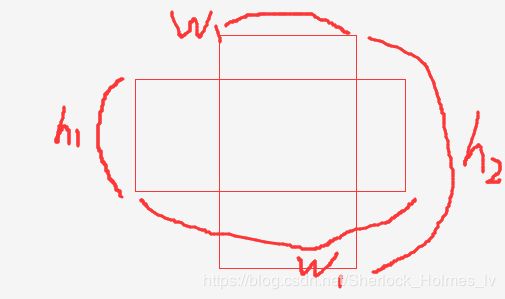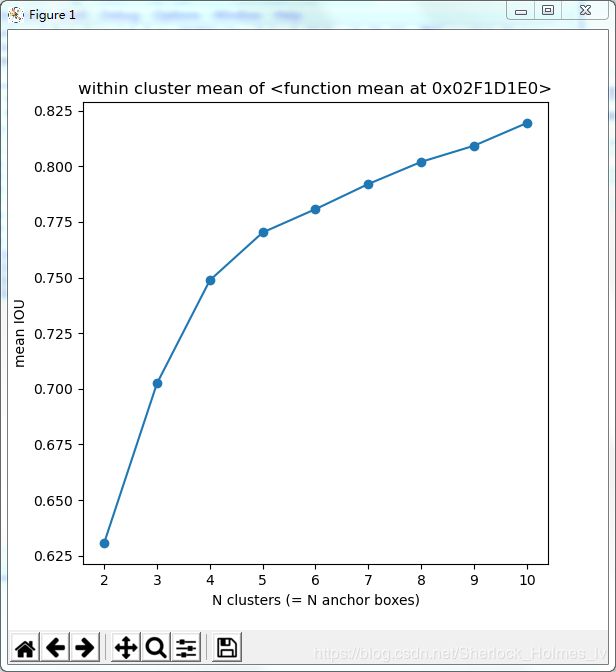用YOLOV2对垃圾进行目标检测《二》
天下武功为快不破 ————————————————搬砖的缘由
二、使用K-means选择archor(瞄框)的形状
K-means聚类有三个步骤:
步骤1:设置集群数量并初始化集群中心
步骤2:将每个项目分配给最近的群集中心。
步骤3:将聚类中心计算为聚类中所有案例的平均值(或中位数)。
重复步骤1和2,直到两次连续迭代产生相同的聚类中心
在步骤1中,使用1-IOU计算到群集中心的距离
在步骤2中,使用中位数来计算聚类中心。
1. standardize bounding box width and hight
def stand_wh():
wh = []
for anno in train_image: # train_image来自上一节中最后得到的数据
aw = float(anno['width']) # width of the original image
ah = float(anno['height']) # height of the original image
for obj in anno["object"]:
w = (obj["xmax"] - obj["xmin"])/aw # make the width range between [0,GRID_W)
h = (obj["ymax"] - obj["ymin"])/ah # make the width range between [0,GRID_H)
temp = [w,h]
wh.append(temp)
wh = np.array(wh)
print("clustering feature data is ready. shape = (N object, width and height) = {}".format(wh.shape))
2. 计算IOU

i n t e r s e c t i o n = m i n ( w 1 , w 2 ) ∗ m i n ( h 1 , h 2 ) intersection = min(w1, w2)*min(h1,h2) intersection=min(w1,w2)∗min(h1,h2)
u n i o n = w 1 ∗ h 1 + w 2 ∗ h 2 union = w1*h1 + w2*h2 union=w1∗h1+w2∗h2
I O U = i n t e r s e c t i o n u n i o n − i n t e r s e c t i o n IOU =\cfrac{intersection}{union - intersection} IOU=union−intersectionintersection
def iou(box, clusters):
'''
:param box: np.array of shape (2,) containing w and h
:param clusters: np.array of shape (N cluster, 2)
'''
x = np.minimum(clusters[:, 0], box[0])
y = np.minimum(clusters[:, 1], box[1])
intersection = x * y
box_area = box[0] * box[1]
cluster_area = clusters[:, 0] * clusters[:, 1]
iou_ = intersection / (box_area + cluster_area - intersection)
return iou_
3. 计算kmeans
def kmeans(boxes, k, dist=np.median,seed=1):
"""
Calculates k-means clustering with the Intersection over Union (IoU) metric.
:param boxes: numpy array of shape (r, 2), where r is the number of rows
:param k: number of clusters
:param dist: distance function
:return: clusters:集群中心点
"""
rows = boxes.shape[0]
distances = np.empty((rows, k)) ## N row x N cluster
last_clusters = np.zeros((rows,))
np.random.seed(seed)
# initialize the cluster centers to be k items
clusters = boxes[np.random.choice(rows, k, replace=False)]
while True:
# Step 1: allocate each item to the closest cluster centers
for icluster in range(k):
distances[:,icluster] = 1 - iou(clusters[icluster], boxes)
nearest_clusters = np.argmin(distances, axis=1)
if (last_clusters == nearest_clusters).all():
break
# Step 2: calculate the cluster centers as mean (or median) of all the cases in the clusters.
for cluster in range(k):
clusters[cluster] = dist(boxes[nearest_clusters == cluster], axis=0)
last_clusters = nearest_clusters
return clusters, nearest_clusters, distances
kmax = 11
wh = stand_wh()
dist = np.mean
results = {}
for k in range(2,kmax):
clusters, nearest_clusters, distances = kmeans(wh,k,seed=2,dist=dist)
WithinClusterMeanDist = np.mean(distances[np.arange(distances.shape[0]),nearest_clusters])
result = {"clusters": clusters,
"nearest_clusters": nearest_clusters,
"distances": distances,
"WithinClusterMeanDist": WithinClusterMeanDist}
print("{:2.0f} clusters: mean IoU = {:5.4f}".format(k,1-result["WithinClusterMeanDist"]))
results[k] = result
4. Elbow方法画出kmeans随着k的增加的变化
plt.figure(figsize=(6,6))
plt.plot(np.arange(2,kmax),
[1 - results[k]["WithinClusterMeanDist"] for k in range(2,kmax)],"o-")
plt.title("within cluster mean of {}".format(dist))
plt.ylabel("mean IOU")
plt.xlabel("N clusters (= N anchor boxes)")
plt.show()
从图中很明显可以看到k=4后直线的斜率变小
[[0.39456522 0.46487029]
[0.40708786 0.84806669]
[0.82108028 0.60499731]
[0.24760711 0.32905857]]
